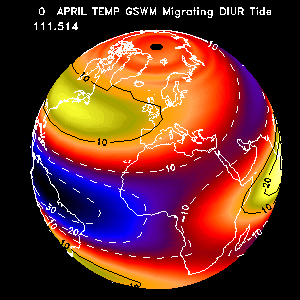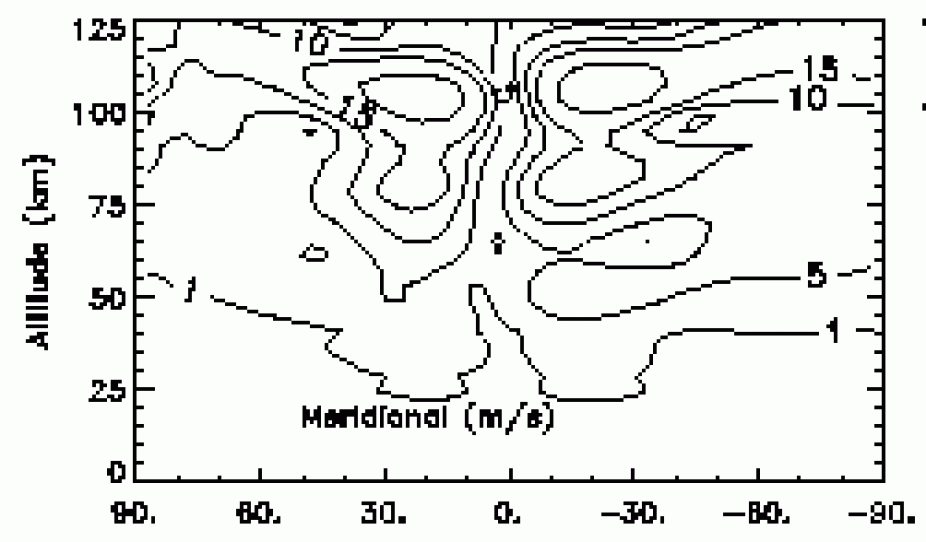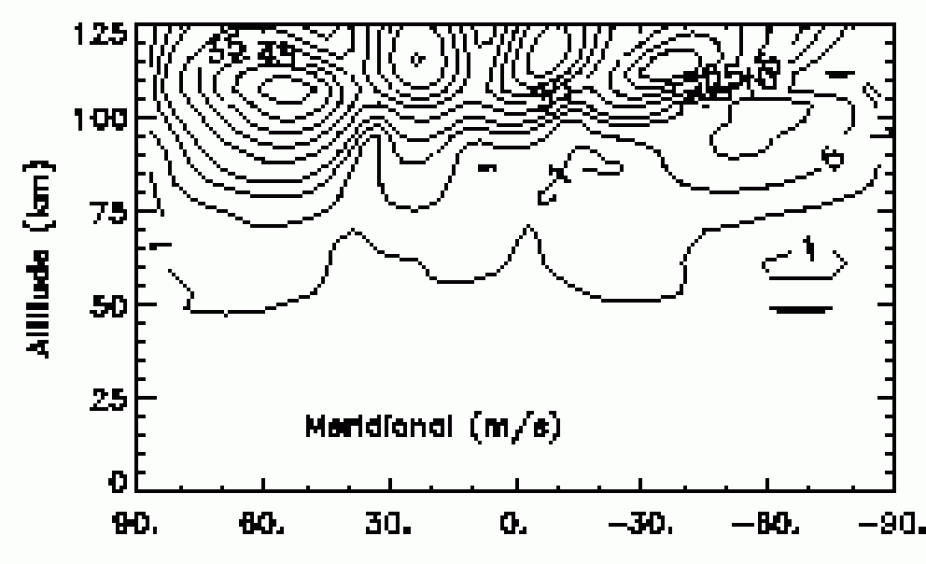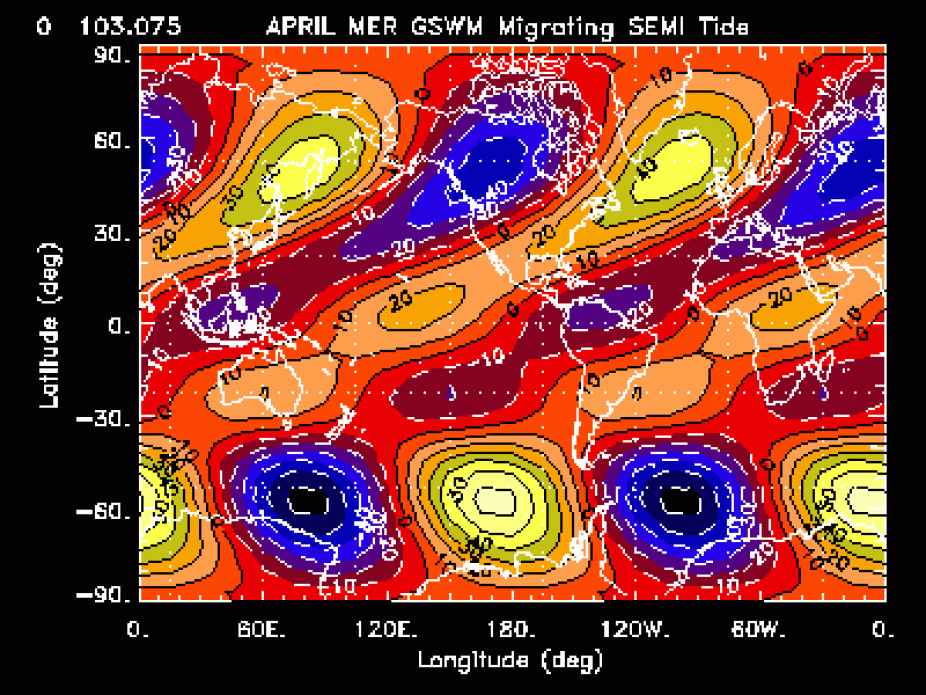Global Scale Wave Model (GSWM)
Scientific Background
Overview
Atmospheric solar tides are global-scale waves with periods that are harmonics of a 24 hour day. Migrating tidal components propagate westward with the apparent motion of the sun, so their zonal wavenumbers are identical to their frequency (in units of "tide maxima per day"). These components are thermally driven by the periodic absorption of solar radiation throughout the atmosphere, primarily the absorption of UV radiation by stratospheric ozone and of IR by water and water vapor in the troposphere.

Movie of GSWM migrating diurnal temperature
It may not be immediately apparent from this description, but the migrating tides do not move relative to the sun, and they therefore act as a steady influence on the atmosphere. Their variation in time to an observer on Earth results from the Earth's rotation through this fixed excitation pattern. Seasonal variations in migrating tides occur as the Earth tilts within this pattern. The animation above illustrates this characteristic: see how a point on the Earth passes "underneath" the migrating tide, just as it passes "underneath" the rays of the sun through the day.
These tides have been studied extensively with mechanistic models for more than 30 years. Ground-based and satellite-borne wind and temperature measurements reveal the strength and the variability of tidal signatures in the mesosphere and lower thermosphere (MLT; ~80-120km). These results confirm that tides often govern the dynamics of that region. Further, salient features of observational signatures agree with predictions of the mechanistic migrating tide models.
However, there are features in the measurements that remain unresolved by current numerical models based on either mechanistic approaches or first principles. Part of the discrepancy may be due to the contribution to the total tide of the non-migrating component. Non-migrating tidal components are also harmonics of a solar day, but unlike migrating tides, they do not have a zonal wavenumber equal to their frequency. This means that they may be stationary, or propagate either eastward or westward. Their driving sources appear to be dominated by the latent heat released by meteorological events in the troposphere.
Mechanistic Analysis of Atmospheric Tidal Waves
A mechanistic view of atmospheric tides breaks the problem into three components: Tidal forcing; the background propagation medium; and damping.
Two sources which drive the migrating tides were already mentioned: The UV energy which is absorbed periodically and re-radiated as heat by stratospheric O3, and IR energy absorbed by tropospheric H2O. Another thermal driver is the latent heat which is stored in water vapor and transported by complex meteorological activity, to be released again in other regions of the globe when the vapor precipitates. This source is theorized to be a less important influence on migrating tides, and more significant for non-migrating tides.
General atmospheric motion that underlies the tides comes from differences in net global heating between the northern and southern hemispheres. This difference results in a meridional energy exchange that causes wind jets, which characterize the unperturbed (background) atmosphere. The winds resulting from this equilibrium are referred to as "geostrophic." Background concentrations of water vapor and ozone also vary with altitude and location on the globe.
Tidal dampening may come from many strong and weak mechanisms. Other short-term or small-scale waves that originate according to terrain, called gravity waves, tend to disrupt tidal components by causing turbulence and accelerating the air along with the global-scale tide. Tides and gravity waves increase in amplitude with altitude due to the decreasing density of the atmosphere. Between 80-100km, at the mesopause, gravity waves become large enough to interfere with diurnal tides by "dragging" the background atmosphere to the phase speed of the tide, and by causing eddy currents that disrupt energy propagation.
Above about 90-100km in the lower thermosphere, the decreasing density of the air causes wave motion to be dominated by molecular diffusion rather than fluid flow, decreasing the efficiency of energy transfer, and further dampening the tides. Above the thermosphere, tides are dissipated by the radiation of energy into space (Newtonian cooling) and drag caused by the tides' acceleration of charged particles in the ionosphere.
Classical Solution
The "classical" solution simplifies the differential equations that describe the tidal motions, in order to make the problem more tractable for analytic approaches. The exclusion of dissipative terms, background winds, and latitudinal gradients in the background atmosphere renders the system of differential equations separable. Eliminating the derivatives with respect to time and longitude for the migrating tide and simplifying yields a single, separable partial differential equation for the perturbation geopotential in terms of altitude and latitude.
References
Description of the Global Scale Wave Model
Major Features
- 2-dimensonal, linearized, steady-state assumptions
- Solves for non-migrating or migrating waves
- Realistic zonal mean atmosphere (a priori)|ASCII output format
Background Climatologies
- Realistic empirical wind, temperature, pressure, density, and ozone zonal mean backgrounds
Tidal Forcing
- Thermospheric absorption of solar extreme ultraviolet (EUV) radiation
- Absorption of solar radiation in the Schumann-Runge (S-R) bands and continuum in the mesopause region
- Strato-mesospheric absorption of solar ultraviolet (UV) radiation
- Tropospheric absorption of solar infrared (IR) radiation
- Tropospheric latent heating associated with deep convective activity (DCA)
Dissipation
- Ion drag
- Thermal conductivity
- Molecular diffusivity
- Eddy diffusivity
- Gravity wave drag
Description of Output
- Sample code to read ASCII output file.
24-Hour (Diurnal) Migrating Solar Tide

Zonal, Meridional, and Vertical Wind, & Temperature Perturbations, Diurnal.

Alt v. Lat Color Contour for January Diurnal Plots.
- Response to IR- and UV-Driven Thermal Forcing is Out of Phase, Reducing Amplitude of Perturbation
- Interactions with Gravity Waves in Mesosphere Reduces Amplitude in Lower Thermosphere
- Higher Equinox
- Amplitudes Amplitude Peaks occur in Mid- to Low Latitudes
- ~25km vertical wavelength
Results: Select GSWM-98 Graphics and GSWM-00 ASCII Output (below)
GSWM-98 8-Panel Amplitude and Phase Contour Plots on a Grid of Altitude vs. Latitude: Zonal, Meridional, and Vertical Wind, & Temperature Perturbations (8.5" X 11" .gif)
- January (Solstice) in Color(25k) or in BW (18k)
- April (Equinox) in Color(28k) or in BW (19k)
- July (Solstice) in Color(26k) or in BW (18k)
- October (Equinox) in Color(28k) or in BW (19k)
GSWM-98 Animated Diurnal Plots
- January North Wind Color Contour .gif: Altitude vs. Latitude (180k)
- April East Wind Color Contour .gif: Altitude vs. Latitude (223k)
- April North Wind Color Contour .gif: Latitude vs. Longitude at 100km (176k)
- April Temperature Color Contour .gif: Altitude vs. Latitude (202k)
GSWM-00 ASCII output files for Migrating Diurnal Calculations
12-HOUR (SEMIDIURNAL) MIGRATING SOLAR TIDE

Zonal, Meridional, and Vertical Wind, & Temperature Perturbations, Semidiurnal.

Lat v. Lon Color Contour, April Semidiurnal Plots.
- Smaller Amplitude Perturbations than Diurnal Tide in Mesosphere
- Longer Wavelength than Diurnal Tide
- Major Amplitude Peaks occur at Mid- to High Latitude, Shift with Season
- Highest Amplitudes occur in Lower Thermosphere
- ~50km vertical wavelength
Results: Select GSWM-98 Graphics and GSWM-00 ASCII Output (below)
GSWM-98 8-Panel Amplitude and Phase Contour Plots on a Grid of Altitude vs. Latitude: Zonal, Meridional, and Vertical Wind, & Temperature Perturbations (8.5" X 11" .gif)
- January (Solstice) in Color(24k) or in Black and White(16k)
- April (Equinox) in Color(25k) or in BW(16k)
- July (Solstice) in Color(23k) or in BW(15k)
- October (Equinox) in Color(25k) or in BW(16k)
GSWM-98 Animated Semidiurnal Results
- January North Wind Color Contour .gif: Altitude vs. Latitude(203k)
- April East Wind Color Contour .gif: Altitude vs. Latitude(179k)
- April North Wind Color Contour .gif: Latitude vs. Longitude at 100km(216k)
- April Temperature Color Contour .gif: Altitude vs. Latitude(220k)
GSWM-00 ASCII output files for Migrating Semidiurnal Calculations
GRAPHICAL OUTPUT FROM COMBINED GSWM-98 MIGRATING HARMONICS
- Semidiurnal Component Dominates in Lower Thermosphere
- Semidiurnal Component Stronger at Higher Latitudes
- Diurnal Component Dominates in Mesosphere near Equator/Subtropics
- Seasonal Dependence due to Respective Diurnal, Semidiurnal Seasonal Shifts